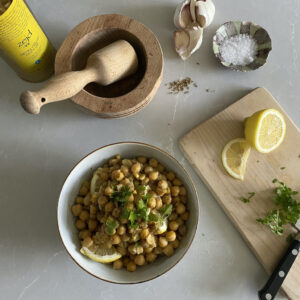balila
Balila is a Lebanese dish using chickpeas, the ever useful store cupboard essential. Given that it’s a simpler form of its famous relation “hummus”, why isn’t it more known in the UK? In fact, it’s even easier to make than hummus and also thought to be healthier than eating puréed chickpeas.
Nada Saleh, a Lebanese food writer living in the UK, highlights the nutritional value of chickpeas in her book A Lebanese Table. “Rich in protein, good fats, carbohydrates, fibre and valuable vitamins and minerals”, the fact that they are also gluten-free may explain their new found popularity in the UK today. Since the chickpeas are eaten whole in balila, this appears to add to its health benefits. Tim Spector points out in Food for Life that “eating whole chickpeas, rather than pulverising them in a food processor, seems to have the most beneficial effect”.
Possibly the trickiest part of the recipe is remembering to soak the chickpeas (in Arabic they’re called hummus /حمص) overnight. A tin will do if you’ve forgotten, but to really celebrate this tasty pulse, Navarrico or queen chickpeas from the Bold Bean Company will set your balila apart. Just as the quality of the chickpeas makes a difference, good olive oil is essential. The recipe requires a fair bit of olive oil and Zejd’s extra virgin olive oil adds not just health benefits to the dish but also a peppery flavour to the crunchy texture of the chickpeas.
To be able to transform chickpeas with the aid of lemon, garlic, cumin and good extra virgin olive oil is empowering. This would be a good dish to recommend anyone heading off to university or leaving home. It’s cheap, doesn’t require fancy equipment and can be made quickly. More importantly it will give them the nutrition they need which can’t be said of most “fast foods”.
makes enough for 4 generous servings
ingredients
300g dried chickpeas (or 2 x 400g tin or a jar of Navarrico)
1-2 garlic cloves
1/2 tsp fine sea salt
120ml Zejd extra virgin olive oil
1 tablespoon of lemon juice
1 tsp cumin seeds, toasted and ground
1 tbsp parsley chopped
2 slices of lemon cut up to serve (optional)
method
- Start the night before, soak the chickpeas in a generous amount of fresh water.
- The next morning, drain and add the chickpeas to a pan, cover with a generous amount of water. Bring to the boil and skim. Reduce the heat and simmer until the chickpeas are soft and easily squashed between your finger and thumb. This will depend on the age of your chickpeas, it could take an hour. If you have a pressure cooker, the cooking process will be much quicker. Some people add 1/2 teaspoon of bicarbonate of soda to speed up the cooking, but it can make the skin of the chickpea harder.
- Crush 1 or 2 cloves of garlic, depending on taste, in a pestle with the salt. Add the lemon juice, and a tablespoon of the extra virgin olive oil and blend. Gradually add the rest of the oil as the mixture binds.
- Drain the tender chickpeas, keeping back a cup of the cooking liquid, and place in a bowl. Add in the garlic and olive oil mixture, with a little of the cooking liquid, and stir well to coat the chickpeas. Taste and add more lemon and salt if needed.
- Gently fry the cumin seeds in a small pan, then crush in a pestle and mortar. Sprinkle on top of the dish, and finish with the chopped parsley and a generous drizzle of extra virgin olive oil. Keep a small dish of ground cumin for those who want to add extra to their plate.
Best eaten warm, drizzle more EVOO over your serving as you scoop up the mixture with a piece of flat bread.
